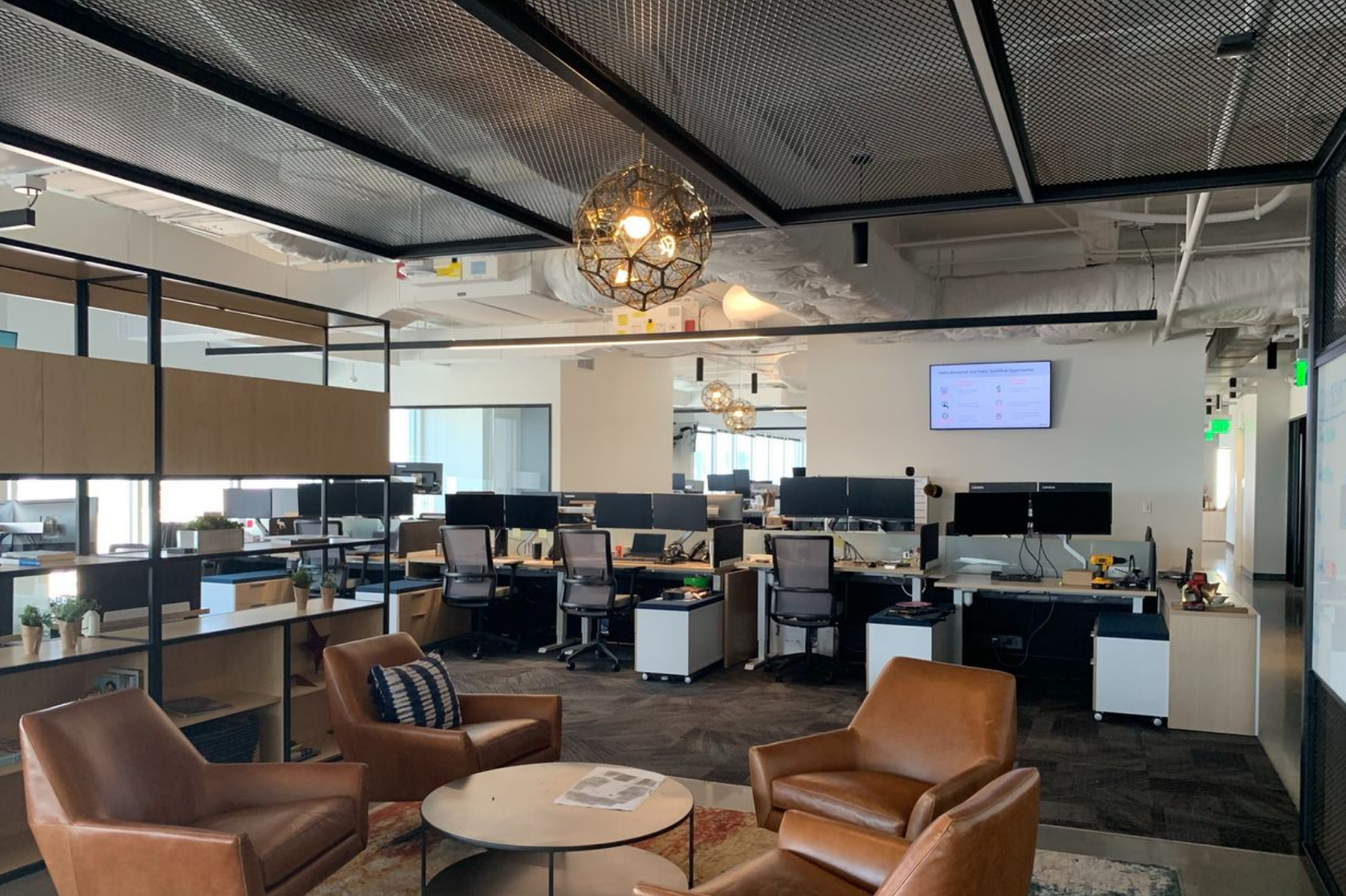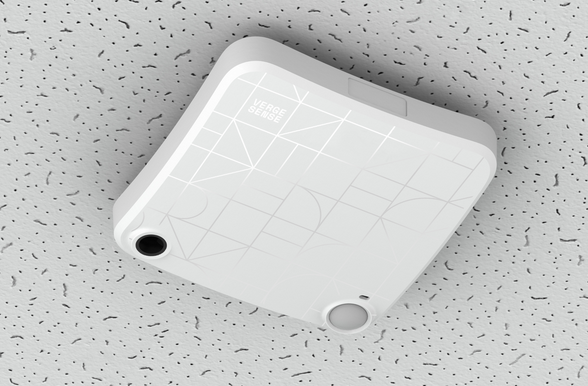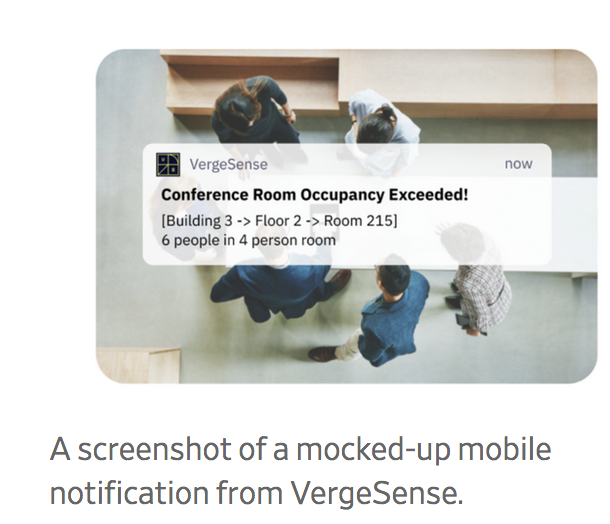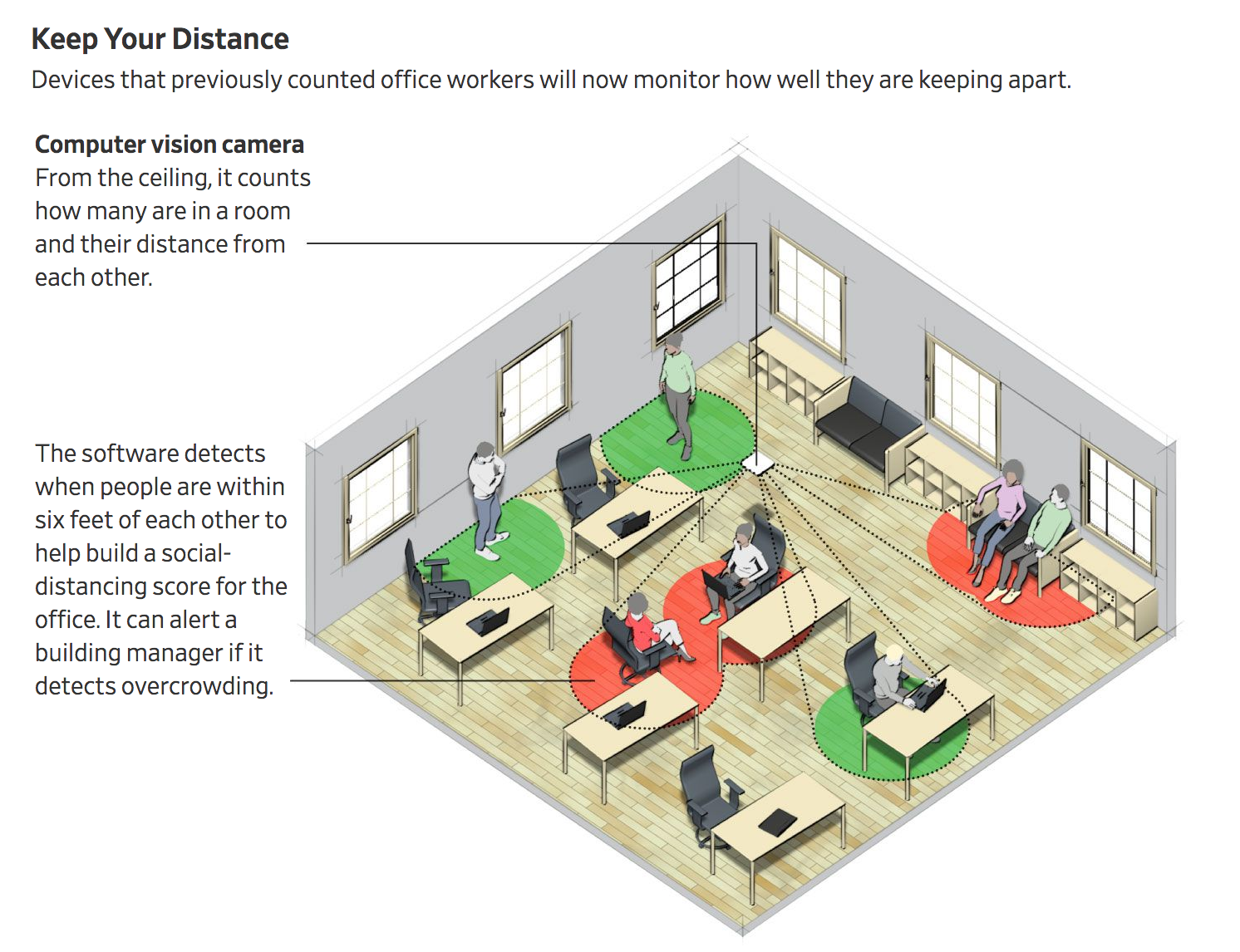Surveillance Cameras Using AI Enforce Social Distancing At Work
Coronavirus concerns lead companies to repurpose sensors that monitor office space, but privacy experts worry about mission creep. Surveillance Cameras Using AI Enforce Social Distancing At Work

Cybersecurity firm Rapid7 Inc. last year installed tiny cameras around its Austin, Texas, office to track how its staff used the space. Now it’s using those same cameras to keep workers apart.
People-counting cameras, also known as artificial-intelligence-powered sensors, have become a niche tool in recent years to help companies better use their office space, and in some cases trim real-estate costs. They are now being repurposed to meet a surge in demand from employers eager to comply with government guidelines on social distancing because of the coronavirus pandemic. However, that versatility is also a concern for privacy advocates, who worry the technology could be changed again to track individuals and monitor productivity.
Traditional occupancy sensors and motion detectors, made by larger firms including Honeywell International Inc. and Texas Instruments Inc., often use infrared technology. Startups populate the newer field of cameras using computer vision, a form of artificial intelligence, to count how many people are in a room and measure how far apart they are. The technology can identify moving bodies or objects but not faces, and the low-resolution images aren’t made available to clients, who instead see data turned into numbers and charts.
Before the pandemic, VergeSense Inc., a San Francisco startup that supplied Rapid7, had nearly 100 companies including Royal Dutch Shell PLC and Quicken Loans Inc. using its cameras to track how staff were using office space. In recent weeks, following increased interest from customers wanting to track physical distance rather than collaboration, it has updated its software to track and score social distancing. The company is profitable and has just under 50 employees.

“Everyday we’re just swamped,” said Chief Executive Dan Ryan, who says the company’s devices are sensors and not cameras because they don’t store images. “Some customers are thinking of having a floor-safety coordinator, and they would also be a potential consumer of information like this. Like ‘I’m detecting overcrowding in the kitchen.’”
Users—typically building facilities managers or real-estate executives—can get notifications on their phone about overcrowding. Each device costs a few hundred dollars, while the analytics software costs under $100 a year to run, Mr. Ryan said.
Offices are undergoing major transformations in anticipation of staff returning, from plexiglass barriers to one-way walking systems, and Rapid7 sees the camera technology as a longer-term investment, said Jamie Kinch, the company’s vice president of real estate.
The approximately 60 ceiling-mounted cameras installed at the company’s Austin office, in conference rooms and above desks, have proved useful by showing how space gets wasted. For instance, one camera mounted over four leather chairs in a chill-out area showed they were only being used 5% of the time, prompting Mr. Kinch’s team to eliminate the space from designs for a new office.
VergeSense’s social-distancing update will give Mr. Kinch a live floor plan, showing which desks are occupied, and highlight any overcrowding in particular locations. He’ll see regular social-distancing scores for the office, which he plans to share with colleagues.
Another VergeSense client is Autodesk Inc., a software developer, which said that while their regular security cameras could give occupancy data, they couldn’t offer other useful details.
“We can’t live without that type of information now to manage our space. We need to know what’s going on,” said Charles Rechsteiner, Autodesk’s director of facilities and corporate real estate. The company said it already has 25 VergeSense cameras at each of its offices in San Francisco and Boston, and plans to install hundreds more at those locations and others, Mr. Rechsteiner said.
Adappt Intelligence Inc. of India has also recently updated its technology to measure social distancing, and has received orders to deploy 10,000 “vision-based cameras” across offices in India and Japan, CEO Vivek Bagri said. Before the pandemic, the six-year-old company, which had 40 employees, had deployed 20,000 cameras across offices in Asia to track how staff were using space. Its devices cost about $200, while the software costs just over $100 a year to run.
Real-estate consulting firm Jones Lang LaSalle Inc. is advising its clients in India to install Adappt’s cameras, saying they could be useful during and after the pandemic.
Companies in India and China are under significant pressure to track staff movements, said Rajat Malhotra, a director of facilities management for JLL in Asia, adding that government officials in both countries regularly visit offices to check they aren’t more than 30% to 50% occupied. Two JLL offices in India were checked in April, he said.
“Governments will want us to provide reporting which is transparent to them,” Mr. Malhotra said. “There’s no better way to measure this than with technology.”
Once pandemic-tracking measures lift, he said, body-tracking cameras can go back to monitoring how well real estate is being used. They could help decide if a company should end a lease agreement to save money, for instance. “It’s all about the productivity of those square feet,” Mr. Malhotra said.
But that ability and willingness to pivot is a cause for concern, said Albert Gidari, director of privacy at the Stanford Center for Internet and Society. “The biggest risk is mission creep, even if the initial implementation is health and safety in the workplace,” he said. Down the line, vendors could repurpose their technology to monitor some other behavior. “It’s not a stretch to see this as a productivity-measurement tool.”
Both VergeSense and Adappt said their technology respected employees’ privacy and didn’t store images. Adappt said it couldn’t identify individuals in the same way Bluetooth or Wi-Fi tracking technology could.
Despite these reassurances, Mr. Gidari said employers should be transparent with workers and consider removing the technology postpandemic. “There’s an open question in my mind about how these systems can be justified,” he said.
Welcome Back To The Office. Your Every Move Will Be Watched
Employers plan new tools to measure office interactions and track workers’ health.
Many Americans heading back to the factory and the office as the coronavirus pandemic eases will soon begin to notice that their every move is being watched or recorded.
In Midtown Manhattan, thermal cameras will measure body temperatures as employees file into a 32-story office tower at Rockefeller Center. The building’s owner, RXR Realty, said it is also developing a mobile app for tenants to monitor—and score—how closely their workers are complying with social distancing.
PricewaterhouseCoopers LLP said it is preparing to launch this month a phone app for employers that traces contacts by analyzing workers’ interactions in the office. More than 50 clients have expressed interest, including some of the nation’s biggest banks, manufacturers and energy companies.
Advertising giant Interpublic Group of Cos . is exploring dividing its 22,000 U.S. employees into three separate groups, according to perceived health risks, which could include age. Workers could be asked to disclose medical and other personal information about themselves and, in some cases, family members.
Interpublic hasn’t signed off on the system yet, but it’s definitely “on the front burner,” said Eric Ossmann, chief medical officer at the medical-advisory firm Vigilint Protective Health Services, which is advising Interpublic. Interpublic said it has only begun preliminary discussions about the system.
“It is a reasonable approach, if you can get through the operational and some of the privacy and regulatory issues,” Dr. Ossmann said.
Many office workers have become used to widespread security cameras and keycards that register entries and exits. After the Sept. 11 terrorist attacks, buildings installed enhanced security measures, including logging in visitors and X-raying briefcases.
The arrival of Covid-19 is taking surveillance to a higher level, with some employers planning to track movements and gather personal information like never before in Western democracies. It marks a new chapter in the debate over privacy, and the trade-offs people are willing to make for safety.
Some companies now see the measures as perhaps the only way to reopen offices without risking a new rise in infections, at least until a vaccine becomes available.
Tracking Employees
Building owners said the systems—similar to measures used in China that helped slow the spread of the virus—promote health and safety, so that employers can better monitor and enforce separation between workers, and quickly determine which employees could have come in contact with an infected colleague.
The pandemic’s “consequences are far-reaching, and it is going to change the way all these places work,” said Amol Sarva, chief executive of flexible-office company Knotel, which is adding features to its app that would allow its customers to track the movements of employees. “When you design a workplace, it’s no longer going to be like ‘Hey, is it cool and fun for my people?’ A major criterion is going to be: ‘Is this place safe and resilient?’ ”
Massachusetts-based health-care software company Athenahealth Inc. is considering checking the temperatures of employees but doesn’t want to track their movements. “We trust our employees,” said Fran Lawler, Athenahealth’s chief human resources officer. “I think our employees would feel like that is a bit invasive.”
Jason M. Schultz, professor of clinical law at New York University, who studies workplace monitoring, predicted the tools might remain after the pandemic. “Employers don’t really have any incentives to remove surveillance once they install it,” he said.
When companies began sending their employees home in March, they focused on keeping productivity high despite the remote setups. In anticipation of workers returning to offices, some added basic precautions, such as extra cleaning, markers on the ground to direct foot traffic and more space between desks. Some plan to reduce overall numbers present by keeping some staff working at home or staggering shifts, and others plan to set up their own testing.
Other companies said these moves don’t go far enough.
RXR, the real-estate company, is testing new systems on its own employees. “We are using ourselves as the guinea pigs,” RXR’s Chief Executive Scott Rechler said.
The company aims to have its social-distancing app ready at the end of May. Workers’ movements are tracked through their smartphones—you get a higher score the more time in the office you are farther than 6 feet from another person. An individual would see his or her own score, and the employer would see aggregate data on how employees are complying with social distancing as a whole.
After the pandemic, RXR said the technology could be used to ensure the most efficient use of space and “the overall wellness of our customers.”
Interpublic, whose ad agencies employ 9,700 people in New York City, began to think about how to safely bring back staffers in early April. After consultation with Dr. Ossmann, the company is exploring options including a system of classifying its U.S. employees in one of three levels.
A worker that tested positive for coronavirus antibodies, indicating they had the infection in the past, would be considered a “Level 1” employee—the lowest risk—and could return to work when states and cities lift work-from-home orders.
Those without antibodies but who are considered a low to moderate risk would count as “Level 2.” This group would include employees who are under 65 years old, don’t live with high-risk people and don’t have chronic diseases including diabetes or hypertension. This group could potentially return to work in a second wave.
Employees over 65, or those who are pregnant, smoke, have chronic diseases or health issues would be considered “Level 3.” These at-risk employees would have to wait the longest to return, Dr. Ossmann said.
A potential sticking point, said Casey Tinnesz, Interpublic’s senior director of crisis management and business continuity, is that personal medical information about employees is private.
Dr. Ossmann has also advised Interpublic that there are shortcomings with Covid-19 antibody testing, including that some tests falsely show people have antibodies to the virus.
Measuring Proximity
Other companies have expressed interest in contact-tracing tools so they can pinpoint which employees may have been exposed to the virus, without needing to shut down entire floors of an office or individual manufacturing plants, said Tom Puthiyamadam, digital products leader at PwC. He said he and his colleagues host about 15 meetings a day with current and potential clients to explain the company’s new tracing app.
The product, installed on an employee’s phone, uses Bluetooth and Wi-Fi data, along with other signals, to determine employees’ proximity to each other within a company building. It doesn’t track someone’s location or analyze data outside of work, Mr. Puthiyamadam said.
If an employee tests positive for the coronavirus, HR administrators can log in to a web portal to determine which other employees may be at risk based on their proximity to that worker in a given time period.
Companies are also doing more to screen arrivals and prevent sick people from entering buildings in the first place. Some employers are now evaluating whether to send a daily questionnaire to workers early every morning, asking staffers how they feel, said Larry Gadea, chief executive of workplace software platform Envoy Inc.
He said at least one large technology client has asked the company to build such a tool. Envoy’s software, used to check-in visitors, track packages and book meeting rooms, is used in 14,000 offices.
Answers to the questionnaire could determine who gains access to the office. Those feeling ill would be reminded to stay home, while employees who respond in a satisfactory way could be given a code to scan in an office lobby to gain entry.
Access management company Okta Inc. might require employees who want to work in one of their 12 global offices to register a day in advance and go through a health and safety check that includes questions about their temperature and other potential symptoms, according to the company’s senior vice president of global workplace services Armen Vartanian.
Feevr, a thermal imaging device developed by X.Labs, said it is launching a precheck option loosely modeled on the Transportation Security Administration’s precheck system at airports. The goal is to reduce lines at buildings of people waiting to have their temperatures checked.
Employees can log into Feevr’s app at home every morning through a facial scan and take their temperature with a digital thermometer. The app sends the temperature to the employer with a timestamp. If it is below the fever threshold, the employee gets a pass for the day.
Envoy’s Mr. Gadea said many employers plan to ask guests if they are experiencing symptoms of Covid-19, and how they got to the office. Public transit is viewed as riskier than private cars.
There are still few agreed upon standards on what tools are effective, and how they should be used while respecting individual privacy, said Steven Feldstein, an associate professor at Boise State University, who studies digital surveillance.
“We’re in a bit of a Wild West,” he said. “In the absence of federal guidelines in the U.S. or other even kind of less explicit formal regulations, but just norms, it’s a little bit of a free for all right now in terms of who’s doing what.”
Some employees might push back on contact-tracing efforts, perhaps by turning off their phones when meeting with people, NYU’s Mr. Schultz said. Employers should clarify to workers what will likely happen if they are forced to self quarantine or take time away from the office, he said.
Existing employment laws that protect against discrimination by age or disability still apply in a pandemic, and asking all employees to disclose health information could open a company to legal liability, said Jennifer Merrigan Fay, an employment-law partner at Goodwin Procter LLP.
Companies have some additional leeway in a pandemic, she said. The White House’s return-to-work guidelines call for employers to make accommodations for vulnerable workers, including those who are elderly or with serious underlying health conditions. That could include allowing people to continue doing their jobs from home.
“If employers are telling people that they cannot come back to work, or that they have to disclose information if they are asymptomatic about their health, I think that you’ll absolutely see challenges to that,” Ms. Merrigan Fay said.
At his building in Rockefeller Center, RXR’s Mr. Rechler predicts office workers will get used to the new procedures, just as they did with security check-ins for visitors following 9/11.
Many workers then were nervous about returning to their high-rise offices, he recalled. Turnstiles in office lobbies became common, front desks started asking for ID cards and garages screened cars for bombs. These measures, once deemed extreme, helped people feel safe, and many are still in use today.
“Over time some of that anxiety went away, and I think the same thing will happen here,” he said.
Related Articles:
Report Says Chinese And Iranian Hackers Seek To Steal Coronavirus Research
28,000 GoDaddy Hosting Accounts Compromised
Some States Dabble In Online Voting, Weighing Pandemic Against Cybersecurity Concerns
Antonopoulos: Chainalysis Is Helping World’s Worst Dictators & Regimes (#GotBitcoin?)
Survey Shows Many BTC Holders Use Hardware Wallet, Have Backup Keys (#GotBitcoin?)
Blockfolio Quietly Patches Years-Old Security Hole That Exposed Source Code (#GotBitcoin?)
Apple iPhone May Be Vulnerable To Email (Mail) Hack
Gates Foundation, WHO And Wuhan Institute of Virology All Hacked!
Google Hack Requires That You Updated Chrome Browser Now To Version: 81.0.4044.113
Privacy-Oriented Browsers Gain Traction (#GotBitcoin?)
Can Blockchain Technology Counter US Anti-Message Encryption Bill? (#GotBitcoin?)
Chinese Military Turns To U.S. University To Conduct Covert Research
CIA Has Had Keys To Global Communication Encryption Since WWII
Hostile Spies Target U.S. With Cyber, Encryption, Big Data, Report Finds
Hackers Stole And Encrypted Data of 5 U.S. Law Firms, Demand 2 Crypto Ransoms
Ex-CIA Engineer Goes On Trial For Massive Leak
Multi One Password (Portable App)
After He Fell For A $40K Phone Scam, His Bank Offered To Help—If He Stayed Quiet (#GotBitcoin?)
Your PGP Key? Make Sure It’s Up To Date
Bezos’ Phone Allegedly Hacked By Account Associated With Crown Prince
Major Companies Shared Vulnerability Used In Travelex Cyberattack (#GotBitcoin?)
Microsoft Releases Patch To Patch Windows Flaw Detected By NSA
VPN Tier List 2020 (Comparison Table)
SEC Market-Surveillance Project Hits Snag Over Hacker Fears
Inside China’s Major US Corporate Hack
Twitter Bug Exposed Millions of User Phone Numbers
U.S. Cyber Officials Give Holiday Shopping Advice For Consumers
Is Cayla The Toy Doll A Domestic Spy?
Google’s “Project Nightingale” Faces Government Inquiry Over Patient Privacy.
Which Password Managers Have Been Hacked?
DNS Over HTTPS Increases User Privacy And Security By Preventing Eavesdropping And Manipulation
Russia Steps Up Efforts To Shield Its Hackers From Extradition To U.S.
Barr Revives Debate Over ‘Warrant-Proof’ Encryption (#GotBitcoin?)
Should Consumers Be Able To Sell Their Own Personal Data?
Doordash Says Security Breach Affected Millions Of People (#GotBitcoin?)
Fraudsters Used AI To Mimic CEO’s Voice In Unusual Cybercrime Case (#GotBitcoin?)
Pearson Hack Exposed Details on Thousands of U.S. Students (#GotBitcoin?)
Cyber Hack Got Access To Over 700,000 IRS Accounts (#GotBitcoin?)
Take A Road Trip With Hotel Hackers (#GotBitcoin?)
Hackers Target Loyalty Rewards Programs (#GotBitcoin?)
Taxpayer Money Finances IRS “Star Trek” Parody (#GotBitcoin?)
IRS Fails To Prevent $1.6 Billion In Tax Identity Theft (#GotBitcoin?)
IRS Workers Who Failed To Pay Taxes Got Bonuses (#GotBitcoin?)
Trump DOJ Declines To Charge Lois Lerner In IRS Scandal (#GotBitcoin?)
DMV Hacked! Your Personal Records Are Now Being Transmitted To Croatia (#GotBitcoin?)
Poor Cyber Practices Plague The Pentagon (#GotBitcoin?)
Tensions Flare As Hackers Root Out Flaws In Voting Machines (#GotBitcoin?)
Overseas Traders Face Charges For Hacking SEC’s Public Filings Site (#GotBitcoin?)
Group Hacks FBI Websites, Posts Personal Info On Agents. Trump Can’t Protect You! (#GotBitcoin?)
SEC Hack Proves Bitcoin Has Better Data Security (#GotBitcoin?)




Leave a Reply
You must be logged in to post a comment.